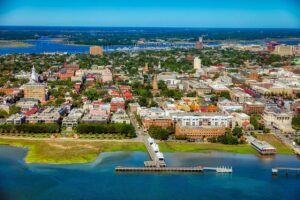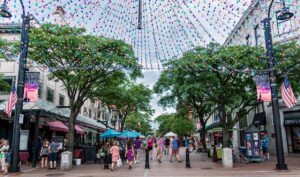When the Puritans set sail in 1620 to flee religious persecution in England, their long journey across the Atlantic was rewarded with a place more beautiful than they had imagined. As those travel-weary settlers exited the Mayflower, they were greeted by one of the most magnificent coastlines in North America. Timber-rich mountains reached down to the water’s edge, and a cornucopia of aquatic creatures swam beneath the waves of New England.
Today’s visitors to New England seaside towns often experience the same sense of awe as the 17th century Pilgrims. The rugged shorelines invite you to explore windswept islands, secret coves and pristine beaches. History buffs are delighted to see dutiful lighthouses standing guard above quaint fishing villages and centuries-old towns. Urban ports welcome guests with world-class cultural venues, architectural treasures and spectacular seafood.
Cruising up the New England coastline in the spring allows visitors to experience the awakening from winter and the arrival of warm breezes that coax flowers to bloom and prompt locals to celebrate the start of a new boating season. To help chart your journey, Marinalife presents a roundup of four ports that showcase the best of the region in the spring.
Mystic, CT
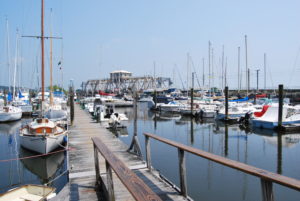
Founded in 1654, Mystic is an irresistible place in New England for those who dream about traveling back in time. For centuries, this charming seaport has offered mariners sanctuary from the Atlantic’s harsh storms. The Bascule Bridge (built in 1920) spans the Mystic River, which flows into Long Island Sound. People and cars cross the drawbridge to reach the bustling downtown district and explore its shops, restaurants and entertainment venues.
Riverside streets are lined with old ship captains’ homes that harken back to the 19th century when America’s whaling fleet grew to nearly 2,700 vessels. To learn about that era, visit Mystic Seaport, America’s largest maritime museum that has collected more than 500 historic ships and seacraft, as well a shipyard, marina, seaport village, planetarium, galleries and relics from its seafaring past. The 1841 Charles Morgan, the last wooden whaling ship in the world, awaits at the dock.
If Colonial history floats your boat, head over to Olde Mistick Village, which was designed in 1720s style with an old-fashioned meeting house, duck pond and gazebo surrounded by more contemporary boutiques, restaurants, theaters and cafés. Fast forward more than a century with a visit to B.F. Clyde’s Cider Mill, America’s oldest steam powered cider mill, which started pressing apples in 1881.
Two other attractions belong on your must-see list. Mystic Aquarium is a fantastic place to enjoy indoor, outdoor and hands-on exhibits that feature a myriad of water creatures from sea lions and beluga whales to tropical fish and African penguins. Inspired by local Impressionist painter Charles H. Davis, the Mystic Museum of Art houses 250 works of art and has a permanent collection of paintings covering the early 20th century to more modern pieces.
Newport, RI
The nickname “City by the Sea” seems like an understatement when you see

the strikingly beautiful shoreline that surrounds Newport. Founded in 1639 by British religious dissenters, it evolved into a key Colonial port that was ransacked by British occupation during the Revolutionary War. To thwart further destruction, Fort Adams was erected from 1824 to 1857 at the entrance to Narragansett Bay, and it remained an active Army fortification through World War II. Now a state park, you can tour the grounds and walk its 2.5-mile loop around the park to catch unforgettable sunsets.
Its magnificent natural surroundings attracted creative minds who turned the town into an artist colony in the 19th century, but its heyday occurred in the early 1900s when Newport became the seaside retreat of America’s prominent families. The Gilded Age is on display in extravagant summer homes built by Vanderbilts (The Breakers and The Marble House), tobacco heiress Doris Duke (Rough Point), Astors and J.P. Morgan. You can tour inside the Gatsby Era mansions or hike the 3.5-mile Cliff Walk to compare the opulent architecture and gardens to nature’s breathtaking scenery along the water.
Newport is renowned in New England for its annual folk and jazz festivals, but even when those events aren’t happening, visitors find plenty to do around town. To discover the seaport’s back-story, start with the Museum of Newport History that features the 17th century English settlers and their rejection of religious persecution. Two famous places of worship underscore the region’s early tolerance of different faiths: Touro Synagogue, which is America’s oldest synagogue, and Trinity Church, with its landmark spire rising above the building that houses an organ once played by George Frederick Handel.
Other noteworthy attractions include sailing and lighthouse tours, the International Tennis Hall of Fame and the National Museum of American Illustration, with displays about iconic artists such as Norman Rockwell.
Boston, MA
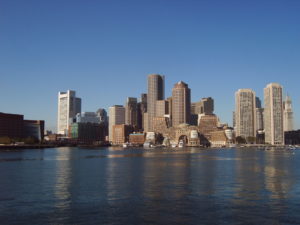
In a city where steel skyscrapers loom high above stone buildings that date back to the 1600s, it’s no surprise that Boston is regarded as the crown jewel of New England’s seaside ports. Founded in 1630, its list of must-see sites reads like a litany of American history: Old North Church, Beacon Hill, Boston Tea Party Ships & Museum, Bunker Hill Monument, Paul Revere House, Old South Meeting House, USS Constitution Museum and more. The Freedom Trail can guide you to many of these sites and take you to great restaurants, taverns and craft breweries when touring makes you thirsty.
Unparalleled cultural venues begin with the Museum of Fine Arts and end with the Boston Symphony Hall. Fenway Park, home of the Red Sox since 1912, is a required stop for sports enthusiasts, and Faneuil Hall Marketplace is a haven for foodies and historians alike.
Whale watching tours have become a popular activity, but arriving by boat presents an opportunity to navigate away from the crowds and see lesser-known aquatic attractions. Boston Harbor National Park contains 34 islands with unique features and historic significance. All but three are open to the public. Some are accessible by ferry, others only by boat.
You can drop anchor, lounge on the beach and camp overnight at Lovell, Peddocks and Grape Islands. At Bumpkin Island, stroll along walking trails and sandy beaches of New England or explore the ruins of an historic farmhouse. At the entrance to Boston Harbor lies Georges Island, where you can explore Fort Warren, a Civil War fort that was active until 1947. Around all the islands are prime fishing spots for cod, bluefish, striped bass and flounder.
Portland, ME
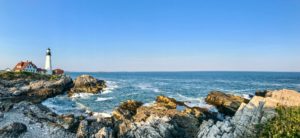
Maine’s largest city is home to about 66,000 full-time residents, but swells to nearly 2 million in the summer, so spring is the best time to get ahead of the crowds. Portland was established in 1633 but ran into some rough spells when it faced Indian raids in the late 1600s and hefty British bombardments during the Revolutionary War. Long since rebuilt, the seaside town has developed a fine reputation for a funky vibe and thriving arts scene.
The Historic Old Port is the heart of the city where cobblestone streets and 19th century warehouses commingle with microbreweries, shops, lively pubs and restaurants dishing up all kinds of seafood from lobster rolls to fresh oysters. Next door to the Old Port is the Arts District, which has an energetic atmosphere along Congress Street thanks to its many galleries, craft stores, art exhibits and theaters. The Portland Museum of Art, Children’s Museum & Theatre, and Portland Stage Company are all nearby.
Along the waterfront is Eastern Promenade, a 68-acre park that separates Back Cove from Fore River and is a popular destination for hiking trails, beaches and grassy areas for picnics. Off the coast lie an archipelago of islands in Casco Bay that challenge boaters to explore as many as possible in a season.
While Portland is laced with historic sites, two unique places are worth a visit. Portland Observatory, built in 1807, is one of the last standing military signal towers along the Atlantic seaboard. This 86-foot tall tribute to the region’s maritime history offers spectacular 360-degree views of the city. Victoria Mansion was built in the mid-1800s as a summer house for hotel magnate Ruggles Sylvester Mores. Its pre-Civil War grandeur showcases an exterior that resembles an Italian villa with ornate towers and balconies, while the interior dazzles visitors with carved wooden panels and plush draperies. Both museums are open to the public.



